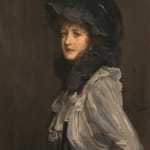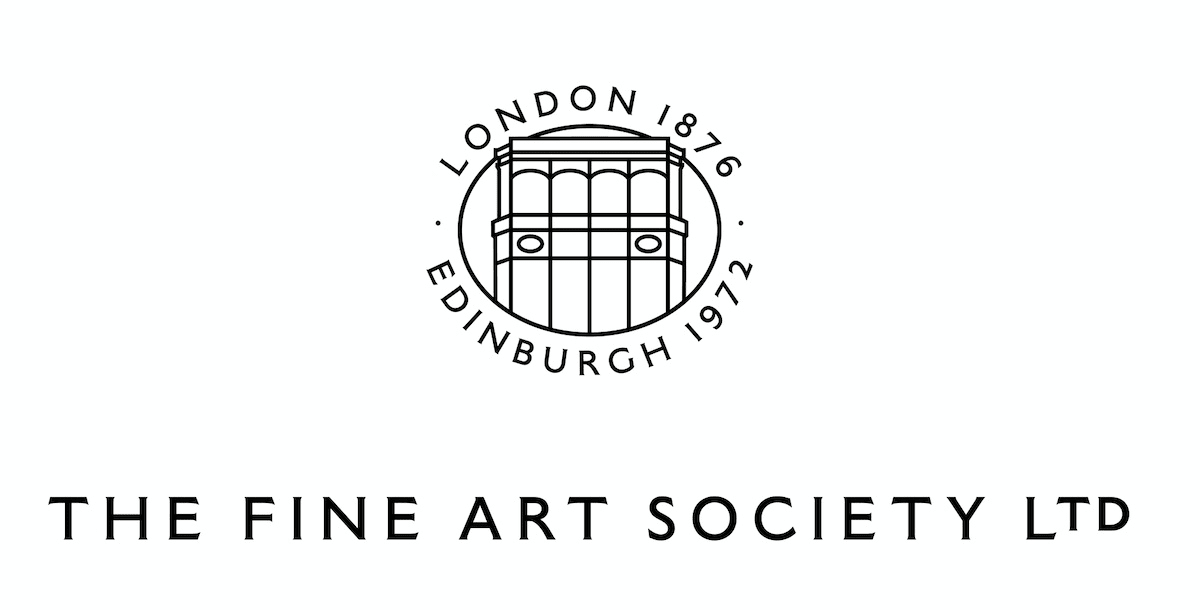


Sir John Lavery RA RSA 1856-1941
Further images
Originally exhibited as A Lady in Black and White in 1901, and identified as Miss May Robbins by Walter Shaw Sparrow, a certain mystery surrounds John Lavery’s retitled Gris et Noir, as it was known to the Paris audience when exhibited the following year. Sometimes thought to represent the artist’s German model, Mary Auras, and mis-dated 1902 by Shaw Sparrow, contemporary illustrations of works contained in the International Society of Sculptors, Painters and Gravers exhibition reveal that the work was painted in the preceding year and despite its subsequent change of title, and the artist’s proclivity for reworking pictures after they had been in exhibitions, it remains unchanged since that first outing. 2
The reason is simple. When first shown, the picture was much admired, and, one of four recent Laverys on display, it was regarded as one of the ‘most notable features’ of a show that contained works by Whistler, Monet, Pissarro, Renoir and other international exhibitors.3 What was described as ‘a very pretty study’ was praised for its spontaneity and ‘true artistic touch’.4 In Paris, where anglomanie was the rage, Lavery was applauded for ‘his cursive and flexible way of measuring out the tones and his beautiful handling of blacks.’5
Whether ‘black and white’ or ‘grey and black’, Lavery’s title, alluding to tonal harmony, placed him in the Whistler camp at a time when the two artists had evolved a close working partnership as President and Vice-President of the International Society. It was Lavery’s job to manage Whistler, and indeed, on at least one occasion, provide overnight accommodation when the American was visiting London. Exchanges that had first occurred in 1887 and were then renewed in Whistler’s Paris studio in 1892, were resumed in Lavery’s studio in 5 Cromwell Place, at the end of the decade. While the older artist proffered his opinions they were not always taken to heart.6 Although he had every appreciation of Whistler and indeed had his own close encounter with the American’s sources in Velázquez, Lavery’s visual eclecticism was more diverse.7
Referring to the present canvas in 1902, James Stanley Little declared that it had ‘much of the tenderness and grace of Romney’.8 While Gainsborough and Lawrence were invoked by others, patrons sometimes approached Lavery with a specific Old Master prototype in mind, presumably because they knew he was highly visually literate.9 By 1914, the painter’s sources even extended to Reynolds and Hoppner, as well as Romney, but whether this was so, or merely a critic’s attempt to impress, is conjecture.10 One can see in the classic ‘Romney’ pose of A Lady in Grey and Black, intimations of what was to come in the tiny A Lady in White c.1903 and the grand full length, Hazel in Black and Gold 1916.
What remains supremely important in A Lady in Grey and Black, however, is to observe the confident placing of the figure, the sensitive tonal harmony and overall, the delicate whiff of romance – what a Belgian critic, adroitly characterized as ‘belle allure’.
1. Camille Mauclair, ‘John Lavery’, L’Art et Les Artistes, 1905, Tome 2, pp. 6-7; ‘On apercoit que peu à peu la grande tendresse, le profonde sens de féminité … le probleme de la vie ailleurante appelée du fond des ombres … Tout a sa consistanée, sa raison d’être …’
2. The quality of reproduction in 1901 clearly makes a definitive judgement impossible.
3. ‘Notes and Comments’, The Yorkshire Post, 7 October 1901, p.4
4. ‘Our London Letter’, Cambridge Daily News, 5 October 1901, p.3; ‘The Picture Galleries’, Lloyds Weekly Newspaper, 6 October 1901, p.4
5. ‘Le Salon’, Gazette des Beaux Arts, Tome 27, Periode 3, 1902, p.464; ‘…sa manière cursive et souple de filer le ton et son beau maniement des noirs.’
6.See for instance Kenneth McConkey, ‘No tampering, no faking no artifice, Her First Communion by John Lavery’, British Art Journal, vol.XXI, Spring 2020, pp. 54-59. Her First Communion (National Gallery of Ireland, Dublin) was shown alongside Gris et Noir in the Salon in 1902.
7. Lavery registered as a copyist in the Prado for two works by Velázquez in May-June 1892.
8. James Stanley Little, ‘A Cosmopolitan Painter: John Lavery’, The Studio, vol.xxvii, 1902, p.118
9. See McConkey 2010, p.94.
10. Hugh Stokes, ‘The Art of Mr Lavery’, Country Life, 13 June 1914, p.890
11. L’Art Moderne, Treizième Année, no.40, October 1893, p.314
(Kenneth McConkey for The Fine Art Society, History of the New, June-July 2023)
Provenance
Nicol Paton Brown (1853-1934) and thence by descentExhibitions
International Society of Sculptors, Painters and Gravers, Third Exhibition, London, 1901, no.73 as A Lady in Black and White (ill. in catalogue); Société Nationale des Beaux-Arts, Salon du Champ-de-Mars, Paris, 1902, no.705 as Gris et Noir; Royal Scottish Academy, Edinburgh, 1903, no.269 as A Lady in Grey and Black; The Grosvenor Gallery, A Retrospective Exhibition of the Works of John Lavery, London, 9 June - 31 July 1914, no.79
Literature
‘Our London Letter’, published in Cambridge Daily News, The Citizen, and Eastern Daily Press, 5 October 1901;
‘The Picture Galleries’, Lloyds Weekly Newspaper, 6 October 1901, pg.4;
‘International Exhibition’, The Morning Post, 7 October 1901, pg.6;
‘Notes and Comments’, The Yorkshire Post, 7 October 1901, pg.4;
‘London Letter’, Bradford Observer, 8 October 1901, pg.4;
B. Kendall, ‘The Third Exhibition of the International Society ...’, The Artist, vol.xxxii, no.263, November 1901, pg.128;
‘Le Salon de la Nationale des Beaux Arts’, L’Écho de Paris and Journal des Débats Politiques, 19 April, 1902;
‘Le Salon’, Gazette des Beaux Arts, Tome 27, Periode 3, 1902, pg.46;
‘The New Paris Salon’, The Scotsman, 18 April 1902, pg.5;
‘The Paris Salon – Pleasing Exhibition’, The Morning Post, 19 April 1902, pg.7;
Gabriel Mourey, ‘Some Paintings and Sculpture at the Paris Salons’, The Studio, vol.xxvi, no.3, June 1902, pg.192;
James Stanley Little, ‘A Cosmopolitan Painter: John Lavery’, The Studio, vol.xxvii, 1902, ill. pp.117-118;
‘The Royal Scottish Academy – The Annual Exhibition’, Aberdeen Press and Journal, 13 February 1903, pg.5;
‘The Royal Scottish Academy Exhibition’, Edinburgh Evening News, 20 February 1903, pg.2;
Walter Shaw Sparrow, John Lavery and his Work (London, 1911) pp.143, 182 as A Lady in Grey and Black: Miss May Robbins;
‘Notable Portraits by John Lavery ...’, The Sphere, 6 June 1914, ill. pg.294;
‘Exhibition of the Work of Mr John Lavery – A Painter of Women’, Evening Mail, 8 June 1914, pg.2;
Kenneth McConkey, John Lavery: A Painter and His World, (Edinburgh, 2010) pp.80, 224



